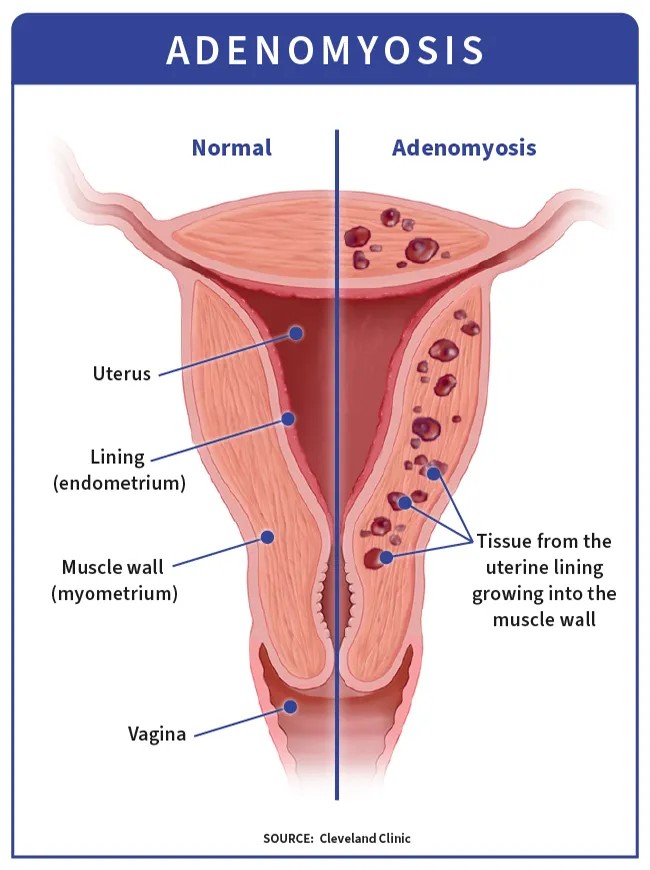Adenomyosis is a condition where the endometrial tissue, which normally lines the uterus, grows into the muscular wall of the uterus (myometrium). This misplaced endometrial tissue continues to function as it normally would during the menstrual cycle – thickening, breaking down, and bleeding – leading to enlarged uterus and painful, heavy periods. While not life-threatening, adenomyosis can significantly impact a woman’s quality of life.
Adenomyosis vs. Endometriosis: Key Differences
Both adenomyosis and endometriosis involve the abnormal growth of endometrial-like tissue outside of its normal location. The key difference lies in where this tissue grows. In adenomyosis, the tissue is found within the uterine muscle. In endometriosis, it grows outside the uterus, affecting organs like the ovaries, fallopian tubes, and even the bowel or bladder. While both conditions can cause pain, adenomyosis is more often associated with heavy menstrual bleeding.
 Adenomyosis infographic
Adenomyosis infographic
Recognizing the Symptoms of Adenomyosis
It’s estimated that about one-third of women with adenomyosis experience no noticeable symptoms. However, when symptoms do occur, they can include:
- Heavy and Prolonged Menstrual Bleeding (Menorrhagia): Periods that are significantly heavier and last longer than usual.
- Severe Menstrual Cramps (Dysmenorrhea): Intense and debilitating pain during menstruation.
- Abdominal Pressure and Bloating: A feeling of fullness or pressure in the lower abdomen.
- Painful Intercourse (Dyspareunia): Pain during or after sexual activity.
- Infertility or Difficulty Conceiving: Challenges in becoming pregnant.
Exploring the Potential Causes of Adenomyosis
The exact cause of adenomyosis remains unknown, but several theories have been proposed:
- Invasive Cell Growth: Endometrial cells may directly invade the myometrium. Prior uterine surgeries, such as Cesarean sections (C-sections), might create pathways for cell migration.
- Developmental Origins: Misplaced cells might originate during fetal development, resulting in the presence of abnormal tissue within the uterine wall from birth.
- Postpartum Inflammation: Inflammation of the uterine lining following childbirth may disrupt the boundary between the endometrium and myometrium.
- Stem Cell Involvement: Some researchers believe that bone marrow stem cells, capable of differentiating into various cell types, may contribute to the development of the abnormal endometrial tissue.
Adenomyosis and its Impact on Fertility
Studies indicate that adenomyosis can negatively affect fertility. Women with adenomyosis may experience difficulty conceiving and an increased risk of miscarriage. The mechanisms behind this link are not fully understood, but potential factors include:
- Distortion of the Uterine Cavity: Adenomyosis can alter the shape and structure of the uterine cavity, potentially hindering embryo implantation.
- Inflammation within the Uterus: The presence of adenomyosis can trigger chronic inflammation in the uterus, creating an unfavorable environment for embryo development.
- Abnormal Uterine Contractions: Irregular uterine contractions may interfere with sperm transport and embryo implantation.
- Hormonal Imbalances: Changes in hormone levels, particularly those crucial for pregnancy, may occur in women with adenomyosis.
Much of the research on adenomyosis and fertility involves women undergoing in vitro fertilization (IVF). Fertility specialists are actively investigating strategies to enhance pregnancy and live birth rates in patients with this condition.

